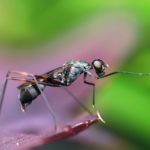The pest control industry has generally relied on the use of chemically-based synthetic insecticides as the key, direct control technique in these integrated pest management (IPM) programs (Gold 1995). The financial backbone of the pest control industry for years has been the “need” for continual chemical cockroach “control.” But safe control is still the best
Our buildings are ideal for cockroaches because they provide food, water, warmth and shelter.If you see the German Cockroach during the day or in areas where there is no food available such as bedrooms then you may have enormous populations.
Cockroaches are tough to kill. They have developed resistance to commercial insecticides, developing skills such as crawling on the walls of your houses and apartments. Continue using commercial insecticides and you’re just helping cockroaches toughen up their stock.
The following is a list of roach extermination techniques using simple tools.
1. The Petroleum Jelly Trap: This method is more practical if you only come across a cockroach once or twice a week, and if you’re dealing with a small colony somewhere around your house. Create your own trap by applying petroleum jelly on the inner walls of a container with steep sides.
Next, make a paper ramp that leads into the container so the cockroach can climb into it. Place a bait inside the container, preferably something that has a strong sweet odor like sugar or apple cider. When the roach smells the sweet odor, it will quickly climb up the ramp and fall into the container. Since the petroleum jelly is sticky, the roach will get trapped. Finally, take the container and flush the roach down the toilet.
2. Boric Acid Poison: Boric acid works by abrading the roach’s shell or cuticle with its harsh particles. With its shell damaged, the roach will soon die of dehydration. They may even die a slow, painful death if you live in a highly humid environment since it takes longer for the roach to lose its moisture. Mix the boric acid with sugar, flour, and water to make it into a paste so it will be more tempting to roaches for better cockroach control
3. Burn them with a Heat Gun: If you see cockroaches everyday in different parts of your house, you need to go after their colonies. Roaches usually live underneath cabinets, cracks in the walls, and anywhere dark and moist. Get a heat gun, the one used for stripping paint, angle its nozzle toward suspected colonies, and blast away. If you hit the right spot, roaches will scramble or die out instantly since the extreme heat will dehydrate and suffocate them.
4. Use a Vacuum Cleaner: Smashing or stepping on cockroaches can be messy and gross. It’s better to use a cordless vacuum cleaner when you see one crawling on your countertop. Simply direct the nozzle on the creepy crawler and it will instantly suck it in. It won’t even have time to spread its wings and fly. You can also try putting boric acid inside the vacuum cleaner so that the roaches won’t be able to get out once they get in.
5. Chuck them out with Chinese Chalk: Chinese chalk is made of Diatomaceous Earth, a naturally occurring chalk-like sedimentary rock. It’s usually available in hardware stores and Chinatown. Chinese chalk acts like boric acid as it abrades the roach’s shell. Just draw lines across shelves, cabinets and walls using the chalk. When cockroaches cross these lines, the particles of the chalk will cut them like broken glass, and they’ll soon die of dehydration.
Cockroaches can be persistent , so you need to regularly apply these techniques to get rid of them completely.
, so you need to regularly apply these techniques to get rid of them completely.
Go to main page Cockroach Control Auckland for best assistance on the job
ABOUT THE AUTHOR
Published by Graeme Stephens owner of Pest Control Auckland and has proudly been providing the following professional services since 1987: pest control, fly control, flea control, insect, cockroach, wasp, bee, flies, fleas, bed bug control, ant control
Last modified: December 14, 2016







